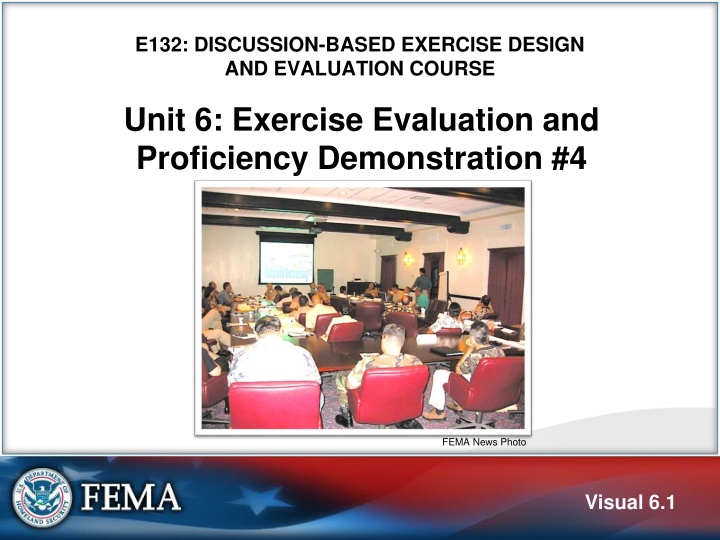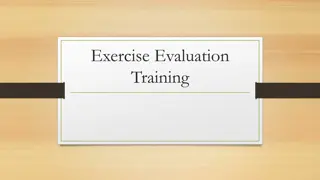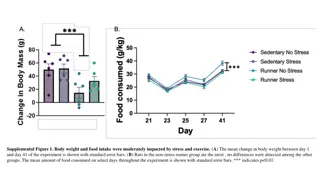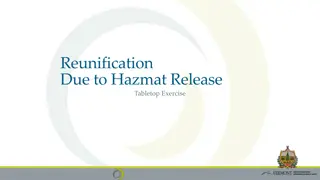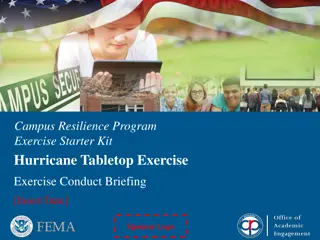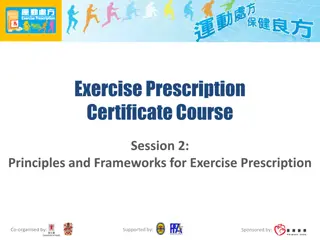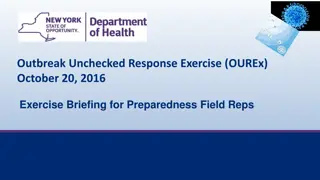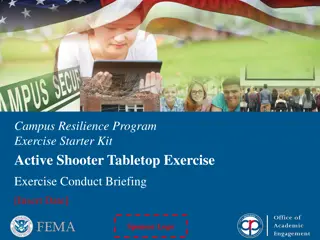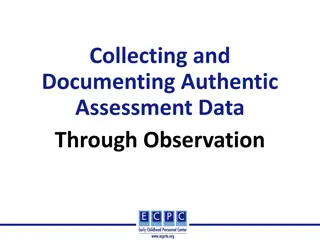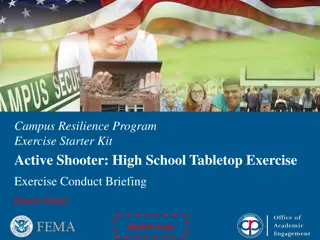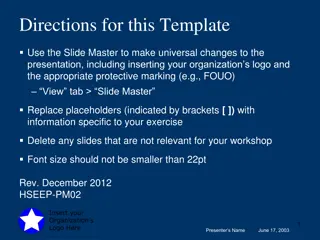Exercise Evaluation Steps and Systematic Approach
This content delves into the importance of evaluating exercises systematically to track corrective actions and improvements. It elaborates on the tasks and phases involved in exercise evaluation, emphasizing the need for honesty in evaluations to avoid wastage of resources. The steps for planning and organizing exercise evaluations, developing support materials, data collection, analysis, and improvement planning are outlined. The provided visuals enhance understanding of exercise evaluation processes.
Download Presentation

Please find below an Image/Link to download the presentation.
The content on the website is provided AS IS for your information and personal use only. It may not be sold, licensed, or shared on other websites without obtaining consent from the author.If you encounter any issues during the download, it is possible that the publisher has removed the file from their server.
You are allowed to download the files provided on this website for personal or commercial use, subject to the condition that they are used lawfully. All files are the property of their respective owners.
The content on the website is provided AS IS for your information and personal use only. It may not be sold, licensed, or shared on other websites without obtaining consent from the author.
E N D
Presentation Transcript
E132: DISCUSSION-BASED EXERCISE DESIGN AND EVALUATION COURSE Unit 6: Exercise Evaluation and Proficiency Demonstration #4 FEMA News Photo Visual 6.1
Unit Objectives By the end of this unit you will be able to: Describe the tasks that occur in steps 1-3 of the eight exercise evaluation steps Describe the rationale for a systematic exercise evaluation process Identify exercise evaluator attributes and pitfalls Visual 6.2
Unit Objectives (contd.) Revise, conduct, and evaluate a tabletop exercise (TTX), using the TTX developed earlier in the course Develop exercise evaluation support material Observe a TTX and collect evaluation data Analyze TTX evaluation data using root cause analysis Visual 6.3
Eight Exercise Evaluation Steps Visual 6.4
The Case for Systematic Exercise Evaluation Cost vs. benefit If we don t evaluate exercises and track corrective actions and improvements, we re setting ourselves up to make the same mistakes over and over If our evaluations are not honest, we are wasting people s time and money Visual 6.5
Evaluation Tasks and the Exercise Cycle HSEEP Exercise Cycle Visual 6.6
Evaluation Tasks and the Exercise Cycle (cont d.) HSEEP Exercise Cycle Phases Design and Development Evaluation Tasks Select Lead Evaluator Develop evaluation plan Select, organize, and train evaluators Observe and document player actions Conduct Evaluation Participate in post-exercise critiques and meetings Develop evaluation reports Track completion of corrective actions* *May not be an evaluator responsibility Improvement Planning Visual 6.7
Step 1: Plan and Organize the Evaluation Part of the exercise design and development process The Exercise Planning Team determines: What information is collected Who collects it How it is collected Evaluators are identified, recruited, and trained Step 1 Plan and organize the evaluation Visual 6.8
Step 1: Plan and Organize the Evaluation (cont d.) Evaluation Plan The Lead Evaluator works with the planning team members to: Define evaluation requirements Prepare a plan for evaluating the exercise Develop evaluation tools Recruit, assign, and train facilitators and evaluators Finalize the plan for evaluation Visual 6.9
Step 1: Plan and Organize the Evaluation (cont d.) Evaluation Plan (cont d.) The evaluation plan should consider: Exercise-specific information Plans, policies, procedures, and agreements Evaluator assignments Evaluator instructions Evaluation tools Visual 6.10
Step 1: Plan and Organize the Evaluation (cont d.) Recruiting Evaluators Occurs after the Lead Evaluator has determined: The number and type of evaluators needed The types of skills required The attributes sought Visual 6.11
Step 1: Plan and Organize the Evaluation (cont d.) Who makes a good evaluator? Discussion Visual 6.12
Step 1: Plan and Organize the Evaluation (cont d.) Evaluators What to Look For Experts in the tasks they evaluate Knowledgeable of the jurisdiction/organization s plans, policies, procedures, and agreements Familiar with the evaluation system Free from other exercise responsibilities NOTE: Evaluators should not interfere with the exercise. They should step in only for safety issues. Visual 6.13
Step 1: Plan and Organize the Evaluation (cont d.) Evaluator Time Requirements Evaluators must be available for: Pre-exercise training/briefing The exercise itself Post-exercise Hot Wash Facilitator and evaluator debriefing After-Action Meeting FEMA News Photo Visual 6.14
Step 1: Plan and Organize the Evaluation (cont d.) Evaluators Errors and Pitfalls Error of Leniency Error of Central Tendency Halo Effect Hypercritical Effect Contamination Tip Sheet for avoiding evaluator pitfalls in your Participant Guide Visual 6.15
Step 1: Plan and Organize the Evaluation (cont d.) Share your experiences with evaluator pitfalls. Have you encountered them while conducting an exercise? Were you able to mitigate them? How did they affect your exercise and your evaluation product? Discussion Visual 6.16
Step 1: Plan and Organize the Evaluation (cont d.) Exercise Objectives Your exercise objectives are the basis for the evaluation of the exercise Visual 6.17
Step 1: Plan and Organize the Evaluation (cont d.) Exercise Evaluation Guides Help evaluators document exercise activities and determine if objectives are met Generally, one packet is used for each objective or core capability being evaluated FEMA News Photo Visual 6.18
Step 1: Plan and Organize the Evaluation (cont d.) When should you begin to develop your EEGs? Discussion Visual 6.19
Step 1: Plan and Organize the Evaluation (cont d.) Developing EEGs Composed of four elements: Core capabilities Organizational capability target(s) Critical task(s) Target rating(s) Visual 6.20
Step 1: Plan and Organize the Evaluation (cont d.) Developing EEGs (cont d.) Pre-Planning Reference C&O meeting Can identified capability targets and critical tasks be tested during the exercise? Research Capability gaps from current threat and hazard assessments Previous/current AAR/IPs Current plans/policies/procedures Visual 6.21
Step 1: Plan and Organize the Evaluation (cont d.) Developing EEGs (cont d.) Select appropriate EEG template (divided by mission area and core capability) Identify capability targets Develop critical tasks (from plans) Number of critical tasks depends on the scope and time allocated for exercise Visual 6.22
Step 1: Plan and Organize the Evaluation (cont d.) Will critical tasks (taken from plans) be different in a TTX vs. a functional or full-scale exercise? Discussion Visual 6.23
Step 1: Plan and Organize the Evaluation (cont d.) Example of critical tasks for discussion-based exercises versus operations-based exercises Discussion-based critical task Describe actions taken to communicate and talk across responding agencies Operations-based critical task Establish the ability to talk across responding first responding agencies Visual 6.24
Step 1: Plan and Organize the Evaluation (cont d.) Evaluation Form Design Critical tasks are used to determine if objectives are successfully demonstrated To develop critical tasks, take the task identified in the objectives and break it into its component steps these steps are the critical tasks Keep the form manageable Try to limit the form to a maximum of 15-20 critical tasks Visual 6.25
Step 1: Plan and Organize the Evaluation (cont d.) Evaluation Form Design Keep questions short and simple Do not ask questions the evaluator cannot answer Visual 6.26
Activity #4: Critical Tasks Visual 6.27
Activity #4: Critical Tasks (cont d.) 1. Refer to Activity #4: Critical Tasks in your Participant Guide 2. Select a capability/objective, and then create two discussion-based exercise, critical tasks for that capability/objective 3. Record your answers on the worksheet 4. Work in groups of two to three 5. You have 15 minutes to complete the activity Visual 6.28
Step 2: Observe the Exercise and Collect Data Observing the exercise and recording the information is only one part Evaluators collect other data, they: Review EOPs, SOPs, SOGs, etc. Record observations and discussions that occur during the exercise Attend the player Hot Wash Collect additional data from records and logs Step 2 Observe the exercise and collect data Visual 6.29
Step 2: Observe the Exercise and Collect Data (cont d.) Evaluators should record: Identified issues How decisions are made Roles and responsibilities Coordination and cooperation issues Recommendations from the group Visual 6.30
Step 2: Observe the Exercise and Collect Data (cont d.) Player Hot Wash After the actual exercise discussions are over, a Hot Wash is held to collect player feedback Hot Wash attendees should include: Exercise players Exercise planning team Facilitators Evaluators Establish rules before start (e.g., respectful environment) FEMA News Photo Visual 6.31
Step 2: Observe the Exercise and Collect Data (cont d.) Player Hot Wash (cont d.) Hot Wash serves to collect observations and thoughts about what occurred during the exercise and how participants thought it went This provides evaluators an opportunity to clarify points or collect missing information Example Hot Wash data in Participant Guide Before we go over it, let s do some brainstorming (no peeking) Visual 6.32
Step 2: Observe the Exercise and Collect Data (cont d.) What should evaluators record during the Hot Wash? Discussion Visual 6.33
Step 2: Observe the Exercise and Collect Data (cont d.) Player Hot Wash (cont d.) Structure the Hot Wash to manage the collection of information you want to get: Ask specific questions Consider branching away from the 3 up/3 down approach Frame questions around selected core capabilities or objectives (did we meet X objective?) Visual 6.34
Step 2: Observe the Exercise and Collect Data (cont d.) How do you structure a Hot Wash in your jurisdiction? Discussion Visual 6.35
Step 2: Observe the Exercise and Collect Data (cont d.) Player Hot Wash Pitfalls Players who perform badly criticize the exercise instead of their own performance Players provide feedback on exercise design and exercise facility (that is what the participant feedback form is for) 3 up/3 down allows participants to freely tell you what is wrong guarantees you will end at the fault of the exercise Players may unintentionally begin to re-exercise the exercise by rehashing issues discussed during the exercise Visual 6.36
Step 1: Plan and Organize the Evaluation (cont d.) How can you mitigate player Hot Wash pitfalls? Discussion Visual 6.37
Step 2: Observe the Exercise and Collect Data (cont d.) In addition to a Hot Wash, other ways to collect data after an exercise are: Participant Feedback Forms Facilitator/Evaluator Debriefing (discussion-based exercises) or C/E Debriefing (operations-based exercises) Visual 6.38
Step 2: Observe the Exercise and Collect Data (cont d.) Participant Feedback Forms As you learned in Unit 4, Participant Feedback Forms capture the following information from the exercise players: Input regarding observed strengths and areas for improvement Constructive criticism about the design, control, or logistics of the exercise to help enhance the planning of future exercises Visual 6.39
Step 2: Observe the Exercise and Collect Data (cont d.) What are the differences between a Participant Feedback Form and a Hot Wash? Discussion Visual 6.40
Step 2: Observe the Exercise and Collect Data (cont d.) Participant Feedback Forms vs. Hot Wash Hot Wash: Does not discuss exercise design Discusses position performance based on plans Participant Feedback Form: Can be anonymous Can be delivered in print or electronically via things like Survey Monkey, email, etc. Addresses exercise design Visual 6.41
Step 2: Observe the Exercise and Collect Data (cont d.) C/E Debriefing a.k.a., Facilitator/Evaluator Debriefing for discussion- based exercises Provides a forum for functional area controllers and evaluators to review the exercise Facilitated by the exercise planning team leader During the debriefing, controllers and evaluators complete and submit their Participant Feedback Forms Debriefing results are captured and may be included in the AAR/IP Visual 6.42
Step 2: Observe the Exercise and Collect Data (cont d.) Following the Discussion-Based Exercise Data gaps will occur evaluators should make every attempt to resolve them Sources for additional data to fill gaps include: Facilitator notes Evaluation/Participant Feedback Forms Visual 6.43
Step 3: Analyze Data Analyze the collected data by: Reconstructing exercise events Reconstructing exercise timelines Developing initial conclusions that may require further research Step 3 Analyze data Visual 6.44
Step 3: Analyze Data (contd.) The evaluation of tabletop exercises (TTXs) focuses on assessing the adequacy of, and familiarity with, existing policies, plans, and procedures FEMA News Photo Visual 6.45
Step 3: Analyze Data (contd.) Root Cause Analysis Root cause is the source of an identified issue It occurs after Hot Wash Evaluators identify discrepancies between what happened and what was supposed to happen, and then, they explore the source of these discrepancies A root cause with an actionable solution should be determined for each issue Visual 6.46
Step 3: Analyze Data (contd.) Root Cause Analysis (cont d.) The Why Staircase Visual 6.47
Step 3: Analyze Data (contd.) Developing Recommendations Evaluation team recommendations are only one possible suggestion to remedy a problem The participating jurisdiction/organization is responsible for developing the recommendation that will address the problem appropriately Visual 6.48
Step 3: Analyze Data (contd.) How could you get participating jurisdictions to include recommendations? Discussion Visual 6.49
Step 3: Analyze Data (contd.) Capturing Lessons Learned Knowledge gained from an experience that provides valuable evidence positive or negative leading to recommendations on how to approach a similar problem in the future Lessons learned should not be just a summary of what went right or wrong, they should provide insight about a change that was made to address a particular issue Visual 6.50
